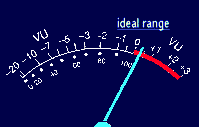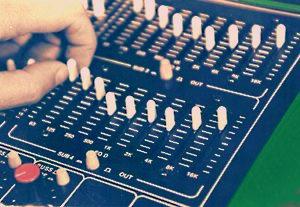|
|
Updated: 08/04/2005 |
|
Television Sound:
Until rather recently, far more attention was paid to video in television than to audio. "Good sound" was when you could make out what was being said; "bad sound" was when you couldn't. This has changed. With the advent of stereo and 5.1 digital sound audiences have much greater expectations. Before we can discuss some of the basic audio production concepts, sound itself must be understood. Sound has two basic characteristics that must be controlled: loudness and frequency.
|
|
Loudness Although sound loudness is measured in decibels (dBs), that term actually refers to two different things. First is dBSPL (for sound pressure loudness), which is a measure of acoustic power. These are sounds we can directly hear with our ears. These decibels go to, and beyond, 135, which is considered the threshold of pain; and, by the way, the point at which permanent ear damage can occur. (The damage, which is irreversible, often goes unnoticed, which probably explains why the average 50-year-old in some countries has better hearing than many teenagers in the United States.) If your ears "ring" after being around a loud sound, this should
be a warning sign that you have crossed the threshold of potential hearing damage.
Musicians who must be around high-level sound use Musician's Plugs-special earplugs
that attenuate sound level without distorting the frequency range. In case you are
thinking about starting your own rock band, HEAR, (Hearing Education and Awareness
for Rockers) at Various sound pressure decibel levels (in dBSPL's) are shown here.
The second use of the term decibel, dBm (for the milliwatt reference level) is a unit of electrical power. These decibels are displayed on loudness meters. In audio production we are primarily interested in dBm, which represents levels of electrical power going through various pieces of audio equipment. Two types of VU meters for measuring
the loudness of sound are in wide use: the digital type and the analog type. Below are three examples of digital meters. The scale on the left side of the large drawing shows modulation percent (percentage of a maximum signal), and the scale on the right is in dB's. Contrary to what logic might dictate, 0dBm (generally just designated 0dB on a VU meter) is not "zero sound" but, in a sense, the opposite, the maximum desirable sound level. (Granted, that's a bit confusing, but, then again, we didn't make up this system!) The 0dB point on the meter is just a reference point. Therefore, it's possible to have a sound level on the meter that registers in negative dBs, just as it's possible to have a temperature of -10 degrees Centigrade or Fahrenheit.
The VU meter below on the
right is the traditional analog The dB level going through audio equipment must be carefully controlled. If the signal is allowed to pass through equipment at too low a level, noise can be introduced when the level is later increased to a normal amplitude (audio level). If the level is too high (significantly above 0 dB or into the
red areas on the VU meter), distortion will result-especially with The animated meter shown here indicates a sound level that is
a bit too high. Ideally, the needle should not go deeply into the red area
this often. Frequency Frequency relates to the basic pitch of a sound-how high or low it is. A frequency of 20 Hz would sound like an extremely low-pitched note on a pipe organ-almost a rumble. At the other end of the scale, 20,000 Hz would be the highest pitched sound that most people can perceive, even higher than the highest note on a violin or piccolo. Frequency is measured in Hertz (Hz) or cycles per second (CPS). A person with exceptionally good hearing will be able to hear sounds from 20-20,000 Hz. (Generally, women can hear higher frequencies than men.) Since both ends of the 20-20,000Hz range represent rather extreme
limits, the more common range used for television production is from 50 to 15,000
Hz. Although it doesn't quite cover the full range that can be perceived by people
with good hearing, this range does cover almost all naturally occurring sounds.
The Frequency-Loudness Relationship Even though sounds of different
frequencies may technically be equal in loudness (register the same on a VU meter),
human hearing does not perceive them as being of equal strength. Because of the reduced sensitivity of the ear to both high and low frequencies, these sounds must be louder to be perceived as being equal to other frequencies. You'll note that a good-quality microphone (the green line)
is relatively "flat" in the all-important 50-15,000 Hz. range. Listening Conditions Equipment and listening conditions also greatly affect how different frequencies will be perceived. To compensate for some of these problems, we can adjust bass and treble controls of playback equipment. More sophisticated equipment will include a graphic
equalizer, A graphic equalizer may be necessary to match audio segments recorded under different conditions, or simply to customize audio playback to the acoustics of a specific listening area. Note that the graphic equalizer shown here can control nine specific frequency areas. Any piece of audio equipment-microphone, amplifier, recorder, or audio speaker-can adversely affect the fidelity of sound. However, it's the microphone (the initial device that transduces sound waves into electrical energy) and the audio speaker (the device that changes electrical energy back into sound waves) that represent the weakest links in audio quality. To some degree it's possible to use graphic equalizers and other audio equipment to "clean up" the frequency response of a poor microphone. However, even the most sophisticated audio techniques can't work miracles. Thus, the better the original audio signal, the better the final product will be.
Sound, both as it's recorded and played back, is more affected by the acoustics of a room or studio than most people realize. In an effort to create totally soundproof studios, early radio
stations used to use thick carpets on the At the other extreme is a room with a tile floor and hard, parallel walls that reflect sound. The result is reverberation (a slight echo) that interferes with the intelligibility of speech. The ideal room for recording or listening to sound has just enough reverberation to sound realistic - similar to your living room possibly - but not enough to reduce the intelligibility of speech.
|



 meter
that has been around in one form or another since the dawn of radio. Although easy
to read, most versions do not accurately respond to short bursts of loud sound.
meter
that has been around in one form or another since the dawn of radio. Although easy
to read, most versions do not accurately respond to short bursts of loud sound. The
red line on the graph (roughly) shows the frequency response of the human
ear to different frequencies.
The
red line on the graph (roughly) shows the frequency response of the human
ear to different frequencies. which
goes a step further and allows specific bands of frequencies to be individually
adjusted for loudness.
which
goes a step further and allows specific bands of frequencies to be individually
adjusted for loudness. floors and heavy soundproofing on the walls. Although possibly successful
as soundproofing, the result was a lifeless and dead effect that we're not used
to hearing in a normal environment, such as in our living rooms. Two types of soundproofing
material are shown on the left.
floors and heavy soundproofing on the walls. Although possibly successful
as soundproofing, the result was a lifeless and dead effect that we're not used
to hearing in a normal environment, such as in our living rooms. Two types of soundproofing
material are shown on the left.